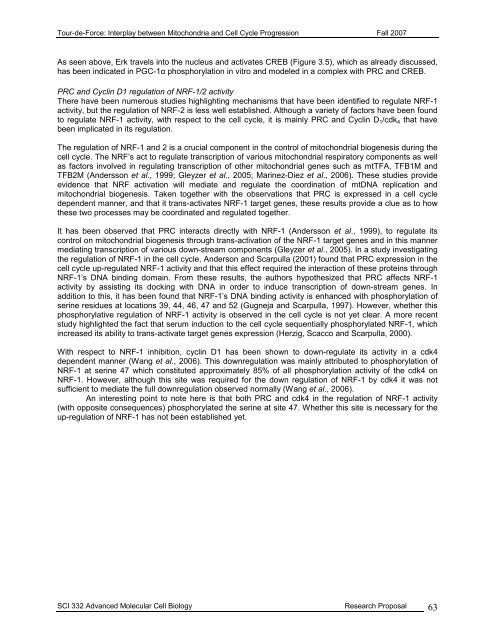Tour-de-Force
Tour-de-Force
Tour-de-Force
You also want an ePaper? Increase the reach of your titles
YUMPU automatically turns print PDFs into web optimized ePapers that Google loves.
<strong>Tour</strong>-<strong>de</strong>-<strong>Force</strong>: Interplay between Mitochondria and Cell Cycle Progression Fall 2007As seen above, Erk travels into the nucleus and activates CREB (Figure 3.5), which as already discussed,has been indicated in PGC-1α phosphorylation in vitro and mo<strong>de</strong>led in a complex with PRC and CREB.PRC and Cyclin D1 regulation of NRF-1/2 activityThere have been numerous studies highlighting mechanisms that have been i<strong>de</strong>ntified to regulate NRF-1activity, but the regulation of NRF-2 is less well established. Although a variety of factors have been foundto regulate NRF-1 activity, with respect to the cell cycle, it is mainly PRC and Cyclin D 1 /cdk 4 that havebeen implicated in its regulation.The regulation of NRF-1 and 2 is a crucial component in the control of mitochondrial biogenesis during thecell cycle. The NRF’s act to regulate transcription of various mitochondrial respiratory components as wellas factors involved in regulating transcription of other mitochondrial genes such as mtTFA, TFB1M andTFB2M (An<strong>de</strong>rsson et al., 1999; Gleyzer et al., 2005; Marinez-Diez et al., 2006). These studies provi<strong>de</strong>evi<strong>de</strong>nce that NRF activation will mediate and regulate the coordination of mtDNA replication andmitochondrial biogenesis. Taken together with the observations that PRC is expressed in a cell cycle<strong>de</strong>pen<strong>de</strong>nt manner, and that it trans-activates NRF-1 target genes, these results provi<strong>de</strong> a clue as to howthese two processes may be coordinated and regulated together.It has been observed that PRC interacts directly with NRF-1 (An<strong>de</strong>rsson et al., 1999), to regulate itscontrol on mitochondrial biogenesis through trans-activation of the NRF-1 target genes and in this mannermediating transcription of various down-stream components (Gleyzer et al., 2005). In a study investigatingthe regulation of NRF-1 in the cell cycle, An<strong>de</strong>rson and Scarpulla (2001) found that PRC expression in thecell cycle up-regulated NRF-1 activity and that this effect required the interaction of these proteins throughNRF-1’s DNA binding domain. From these results, the authors hypothesized that PRC affects NRF-1activity by assisting its docking with DNA in or<strong>de</strong>r to induce transcription of down-stream genes. Inaddition to this, it has been found that NRF-1’s DNA binding activity is enhanced with phosphorylation ofserine residues at locations 39, 44, 46, 47 and 52 (Gugneja and Scarpulla, 1997). However, whether thisphosphorylative regulation of NRF-1 activity is observed in the cell cycle is not yet clear. A more recentstudy highlighted the fact that serum induction to the cell cycle sequentially phosphorylated NRF-1, whichincreased its ability to trans-activate target genes expression (Herzig, Scacco and Scarpulla, 2000).With respect to NRF-1 inhibition, cyclin D1 has been shown to down-regulate its activity in a cdk4<strong>de</strong>pen<strong>de</strong>nt manner (Wang et al., 2006). This downregulation was mainly attributed to phosphorylation ofNRF-1 at serine 47 which constituted approximately 85% of all phosphorylation activity of the cdk4 onNRF-1. However, although this site was required for the down regulation of NRF-1 by cdk4 it was notsufficient to mediate the full downregulation observed normally (Wang et al., 2006).An interesting point to note here is that both PRC and cdk4 in the regulation of NRF-1 activity(with opposite consequences) phosphorylated the serine at site 47. Whether this site is necessary for theup-regulation of NRF-1 has not been established yet.SCI 332 Advanced Molecular Cell Biology Research Proposal 63
















